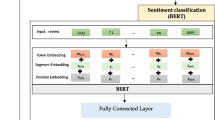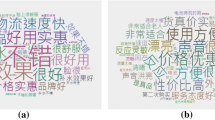Abstract
Several e-commerce sites are reaping the benefits of Cross-Domain Recommendation (CDR) systems to cross-sell products, guide new users and increase revenues. Current research works augment user-item ratings with a variety of auxiliary information such as location, personality, geo-tags and multimedia content that link multiple domains to provide effective CDR. In this paper, we propose a fresh perspective for generating recommendations across different domains by tapping the emotions that are encapsulated within user generated textual content such as reviews, blogs and comments. Such emotions serve as strong socio-psychological links between various entertainments domains and have the potential to obviate the cold start problems. Our CDR scheme uses an enriched emotion lexicon to analyze the emotions in online content expressed by users in the source and target domains and generates emotion-profiles of items and users in both domains. Subsequently, it applies collaborative filtering to match these profiles in order to recommend items in the target domain. We illustrate the working of our emotion-based CDR scheme using the movie and book domains as a case study. Experimental results on Movielens and Bookcrossing datasets yield 28.9% F1-measure which is a marked improvement of 71.1% as compared with a recently reported topic modeling approach to CDR for entertainment domains.







Similar content being viewed by others
Notes
MovieLens Dataset: http://grouplens.org/datasets/movielens/
BookCrossing Dataset: http://www2.informatik.uni-freiburg.de/˜cziegler/BX/
Zazie: http://www.zazie.it
References
Adomavicius G, Tuzhilin A (2005) Toward the next generation of recommender systems: a survey of the state of-the-art and possible extensions. IEEE Trans Knowl Data Eng 17:734–749. doi:10.1109/TKDE.2005.99
Alderson M (2016) Connecting with audiences through character emotions. https://www.writersstore.com/connecting-with-audiences-through-character-emotions. Accessed 21 Oct 2016
Aman S, Szpakowicz S (2007) Identifying expressions of emotion in text. In: International Conference on Text, Speech and Dialogue. Springer, Berlin, pp 196–205
Banerjee S, Pedersen T (2002) An adapted Lesk algorithm for word sense disambiguation using WordNet. Proc Springer Berlin Heidelberg. International Conference on Intelligent Text Processing and Computational Linguistics: pp. 136–145
Bill RW, Liu Y, McInnes BT, Melton GB, Pedersen T, Pakhomov S. (2012) Evaluating semantic relatedness and similarity measures with standardized meddra queries. AMIA Annual Symposium Proc, volume 2012, page 43 American Medical Informatics Association
Cantador I, Fernández-Tobías I, Berkovsky S et al (2015) Cross-domain recommender systems. In: Recommender systems handbook. Springer US, p 919–959
Chakraverty S, Sharma S, Bhalla I (2015) Emotion–location mapping and analysis using twitter. Journal of Information & Knowledge Management 14(03):1550022
Chiang HS, Huang TC (2015) User-adapted travel planning system for personalized schedule recommendation. Information Fusion 21:3–17
Chung R, Sundaram D, Srinivasan A (2007) Integrated personal recommender systems. Proc ACM ninth international conference on Electronic commerce, p 65–74
Cremonesi P, Tripodi A, Turrin R (2011) Cross-domain recommender systems. Proc 2011 I.E. 11th International Conference on Data Mining Workshops 496–503
Derks T (n.d.). Filmsite Horror Films. http://www.filmsite.org/horrorfilms.html. Accessed 21 Oct 2016
Ekman P (1992) An argument for basic emotions. Cognit Emot 6(3–4):169–200. doi:10.1080/02699939208411068
Fernández-Tobías I, Cantador I, Kaminskas M, Ricci F (2011) A generic semantic-based framework for cross-domain recommendation. Proc of the ACM 2nd International Workshop on Information Heterogeneity and Fusion in Recommender Systems: 25–32
Fernández-Tobías I, Cantador I, Plaza L (2013) An emotion dimensional model based on social tags: Crossing folksonomies and enhancing recommendations. Proc Springer Berlin Heidelberg. International Conference on Electronic Commerce and Web Technologies, p 88–100
Fernández-Tobías I, Braunhofer M, Elahi M et al (2015) Alleviating the new user problem in collaborative filtering by exploiting personality information. User Model User-Adap Inter 1–35
Find me an Author (n.d.). http://www.findmeanauthor.com. Accessed 21 Oct 2016
Franzoni V, Poggioni V, Zollo F (2013) Automated classification of book blurbs according to the emotional tags of the social network Zazie. In: ESSEM@ AI* IA, p 83–94
Gao S, Luo H, Chen D et al (2013) Cross-domain recommendation via cluster-level latent factor model. Proc Joint European Conference on Machine Learning and Knowledge Discovery in Databases: 161–176
Handel S (2011) Classification of emotions. http://www.theemotionmachine.com/classification-of-Emotions. Accessed Oct 2016
Harper FM, Konstan JA (2016) The movielens datasets: history and context. ACM Transactions on Interactive Intelligent Systems (TiiS) 5(4):19. doi:10.1145/2827872
Johnson DH, Sinanovic S (2001) Symmetrizing the Kullback–Leibler ´ distance, Technical Report, Rice University
Kaminskas M, Ricci F (2011) Location-adapted music recommendation using tags. Proc Springer Berlin Heidelberg. International Conference on User Modeling, Adaptation, and Personalization, p 183–194
Karthik K, Ponnusamy R (2011) Adaptive machine learning approach for emotional email classification In: International Conference on Human-Computer Interaction. Springer, Berlin, pp 552–558
Kumar A, Kumar N, Hussain M, et al (2014) Semantic clustering-based cross-Domain recommendation. Proc Computational Intelligence and Data Mining (CIDM):137–141
Li B, Yang Q, Xue X (2009) Transfer learning for collaborative filtering via a rating-matrix generative Model. Proc of the 26th Annual International Conference on Machine Learning: 617–624
Low Y, Agarwal D, Smola AJ (2011) Multiple domain user personalization. Proc of the 17th ACM SIGKDD international conference on Knowledge discovery and data mining, p 123–131
Majid A, Chen L, Chen G et al (2013) A context-aware personalized travel recommendation system based on geotagged social media data mining. Int J Geogr Inf Sci 27(4):662–684
Miller GA (1995) WordNet: a lexical database for English. Commun ACM 38(11):39–41
Pan W, Liu NN, Xiang, EW et al (2011) Transfer learning to predict missing ratings via heterogeneous user feedbacks. Proc International Joint Conference on Artificial Intelligence 22(3): 2318
Pan W, Xiang EW, Yang Q (2012) Transfer learning in collaborative filtering with uncertain ratings. In AAAI
Pazzani MJ, Billsus D (2007) Content-based recommendation systems. In: The adaptive web. Springer, Berlin, p 25–341
Rawashdeh M, Alhamid MF, Alja’am JM et al (2016) Tag-based personalized recommendation in social media services. Multimedia Tools and Applications 75:13299. doi:10.1007/s11042-015-2813-0
Reddy S, Inumella A, Singh N, Sangal R (2010) Hindi semantic category labeling using semantic relatedness measures. In: Proceedings of Global WordNet Conference, p 448–453
Redfern N (1995) Emotion, Genre and the Hollywood Paranoid Film. https://nickredfern.wordpress.com/2009/05/07/emotion-genre-and-the-hollywood-paranoid-film/. Accessed 21 Oct 2016
Resnick P, Iacovou N, Suchak M et al (1994) GroupLens: an open architecture for collaborative filtering of net news. In: Proceedings of the 1994 ACM conference on Computer supported cooperative work, p 175–186. ACM
Russel JA (1980) A circumplex model of affect. J Pers Soc Psychol 39:1161–1178. doi:10.1037/h0077714
Saraswat M, Chakraverty S, Mahajan N, Tokas N (2016) On using reviews and comments for cross domain recommendations and decision making. In: Computing for Sustainable Global Development (INDIACom), 2016 3rd International Conference on IEEE, p 3656–3659
Schafer JB, Konstan J, Riedl J (1999) Recommender systems in e-commerce. Proc1st ACM conference on Electronic commerce p 158–166
Schafer JB, Frankowski D, Herlocker J et al (2007) Collaborative filtering recommender systems. The adaptive web Springer, Berlin Heidelberg, pp 91–324
Shi Y, Larson M, Hanjalic A (2010) Mining mood-specific movie similarity with matrix factorization for context-aware recommendation. Proc of the workshop on context-aware movie recommendation, p 34–40
Shi Y, Larson M, Hanjalic A (2013) Generalized tag-induced cross-domain collaborative filtering. CoRR, abs/1302:.4888. doi: 10.1145/0000000.0000000
Shi Y, Larson M, Hanjalic A (2014) Collaborative filtering beyond the user-item matrix: a survey of the state of the art and future challenges. ACM Comput Surv, 47(1)
Tang J, Wu S, Sun J, Su H (2012) Cross-domain collaboration recommendation. Proc of the 18th ACM SIGKDD international conference on Knowledge discovery and data mining, p 1285–1293
Thayer RE (1990) The biopsychology of mood and arousal. Oxford University Press
Winoto P, Tang TY (2010) The role of user mood in movie recommendations. Expert Syst Appl 37(8):6086–6092
Yang YH, Lin YC, Su YF, Chen HH (2007) Music emotion classification: a regression approach. In: 2007 I.E. International Conference on Multimedia and Expo, p 208–211
Zhang D, He T, Liu Y et al (2014) A carpooling recommendation system for taxicab services. IEEE Transactions on Emerging Topics in Computing 2(3):254–266
Ziegler CN, McNee SM, Konstan JA et al (2005) Improving recommendation lists through Topic diversification. Proc in ACM 14th international conference on World Wide Web, p 22–32
Author information
Authors and Affiliations
Corresponding author
Rights and permissions
About this article
Cite this article
Chakraverty, S., Saraswat, M. Review based emotion profiles for cross domain recommendation. Multimed Tools Appl 76, 25827–25850 (2017). https://doi.org/10.1007/s11042-017-4767-x
Received:
Revised:
Accepted:
Published:
Issue Date:
DOI: https://doi.org/10.1007/s11042-017-4767-x




